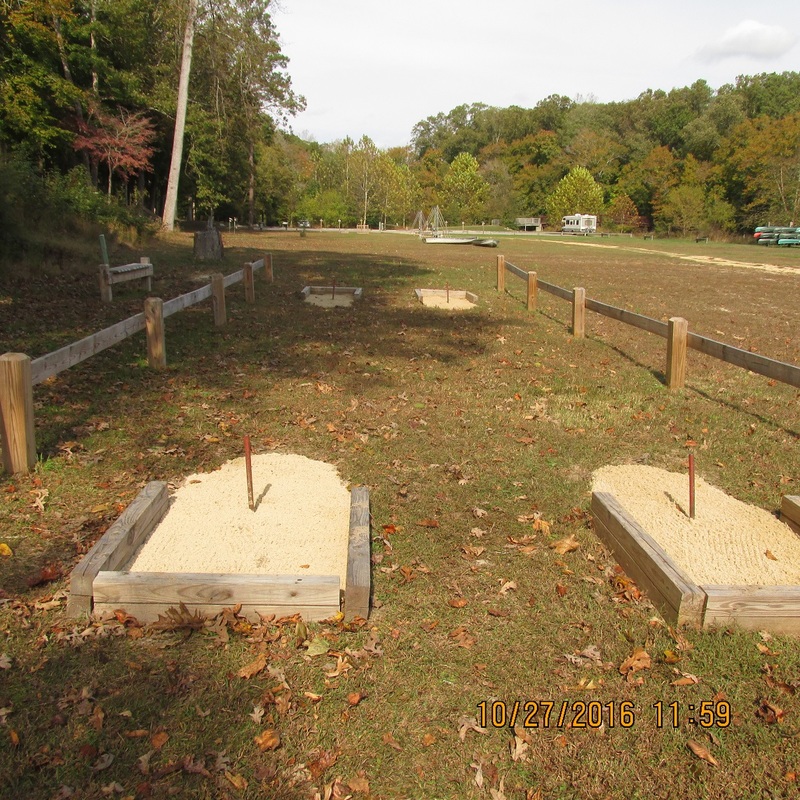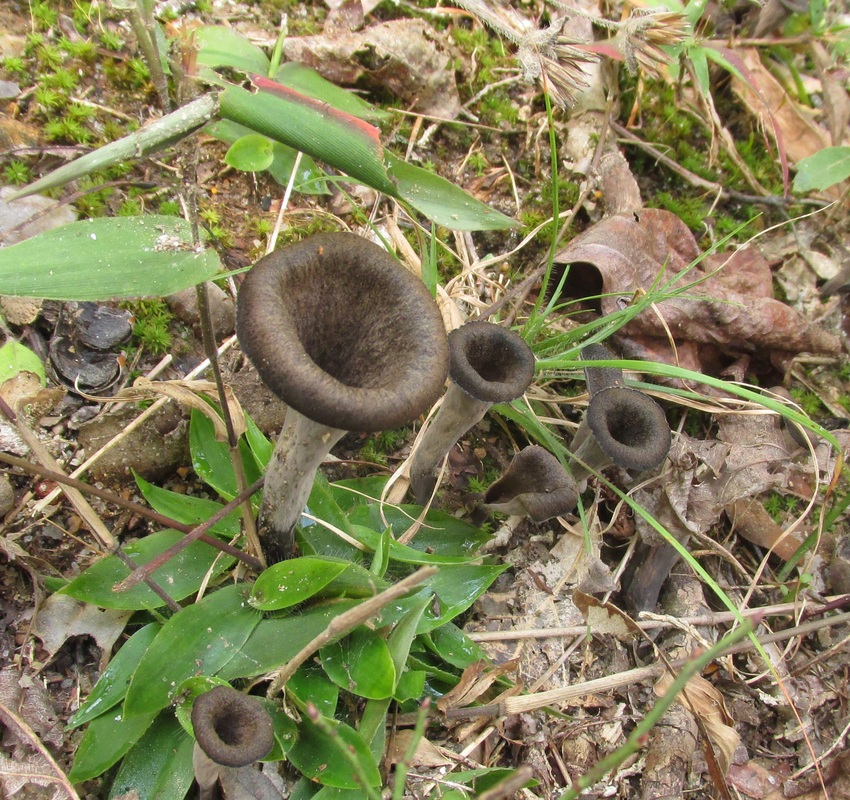|
Tree of Heaven, or Ailanthus, occurs in the park mostly in scattered individual plants or small patches. A small patch will develop near a mature seed-producing tree where there has been logging or other disturbance. Large patches, such as you will see along some roadsides, are rare. The largest one I've found so far, coveriing about half an acre, is not far from the Equestrian Center. This summer we went through this patch, pulling up small stems and cutting most of the large ones. Some of the cut stumps and the largest trunks were treated with herbicide. A couple of months later, this is what the site looks like; lots of small sprouts, of which many are seedlings responding to the opening of the canopy. The treatment now called for is hand-pulling and uprooting all these sprouts, and that is in process with another hour or two of work to do.
0 Comments
It's easy to be distracted at Pocahontas. Landscape gardening is a distraction in the sense that my real objective in the park is management of invasive plant species. I just can't make my way around the public-use areas of the park without seeing that the landscape beds need to be tended. In another instance I was recently distracted from tending my daughter's landscaping when I was asked if I had a use for several cubic feet of mortar sand. My reply at the time was no, but later, while supporting the Clean Virginia Waterways cleanup, I was distracted by seeing that the horseshoe courts on the recreation field needed to be cleaned and refreshed. So, this distraction let to the little project of refurbishing, with some help, the horseshoe courts with donated sand, instead of tending to the landscape beds.
Actually, both tasks were accomplished today. A few weeds and spent flowering stems were removed from the Heritage Center Garden. I transplanted five American Beautyberry plants from the Native Plant Garden to the CCC Field. At the CCC Field I spread some mulch and did some weeding and hoeing. The "winter annual" weeds are growing again, and it seems as if the mulch disappears faster than I can spread it. There are scattered plants and scattered patches of Ailanthus (Tree of Heaven) throughout the park. Ailanthus is considered to be one of our "most unwanted" plants (interesting article here). With herbicide treatment available only on rare occasions, I try to uproot as many small trees as possible, and the larger ones I cut, leaving about three feet of stump. The tree then re-sprouts from that stump, and I go back periodically to cut off the sprouts, With sufficient persistence, this will eventually kill the tree. Returning to one of these sites today, a year after the initial cutting, I found that some of the stems had sprouted vigorous new shoots. So vigorous, in fact, that the leaves, which are compound, exceed the largest size given in the official plant descriptions. The leaf with its compound leaflets shown here is four and half feet long. Note the pruning shears along the base of the leaf.
A little of this and a little of that, today in the gardens. We spent a few minutes at the CCC Field, weeding and spreading some buckets of mulch. I particularly wanted to mark a grape-fern which I found under the mountain laurels. Grape-fern is a small fern-like plant that is common in these woods, but I suspect it is rarely noticed from the walking trails.
To help visitors identify more of the plants in the gardens, in place of the black-and-silver plant tags, I have obtained "garden tags", the same tags but with the garden name and a QR code link to the garden on Plants Map. A visitor with a smartphone (some 60% of us now have them) can pull up the garden and peruse the labelled images of the plants in the garden. We installed the garden tags at the CCC Museum, the Heritage Center and the Native Plant Garden. After taking out a few clumps of broomsedge, we left the Native Plant Garden and visited the Bright Hope Butterfly Garden. This garden is the project of a member of Pocahontas Chapter, Virginia Master Naturalists, and is not part of our maintenance routine. Our purpose there was primarily to receive from the Friends of Pocahontas firewood crew some bucked log sections to be used for casual seating around the garden. The final stop for today was at the Powhatan Dining Hall Garden. There we cut back the spent flower stems, pulled up the few weeds and pruned the elderberries. The only plant still flowering is a tall, showy aster which we have yet to identify. To close out the morning's work, we took a short walk into the woods to inspect a small vernal salamander pool. It had filled with water in the recent heavy rains, but was once again dry. On the walk we came across a cluster of Black Trumpet mushrooms (photo below).  In the spring of this year the director of DCR's Stewardship Virginia program held a nature camp for youth. In preparation for the camp, she planted a variety of wildflowers in the area above this garden where the grass is normally mowed. One of our tasks for today was to transplant all those "outliers" closer to the garden proper so that mowing could be resumed next year. Thanks to the recent soaking rains, the ground was just right for digging and planting. With that done, we checked on the CCC Museum Garden and found it to be in good shape, so we moved on to clean out the weeds in the Heritage Center Garden and the Native Plant Garden. The most abundant grass in the Native Plant Garden is Broomsedge. It functions there primarily as a free substitute for wood mulch, which must be purchased every year. Depending on your point of view, it can be either attractive or unkempt, but it does help to soak up the rain and to retain moisture during dry spells. The downside is that Broomsedge self-sows freely, so we have to keep weeding it out to keep it from completely overrunning the bed. I started the weekly landscaping maintenance at the District Office, where there were just a few weeds in the mulch, and a few Liriope were once again appearing. Dispatching those, I trimmed the now leafless Swamp Milkweed stems and seed-heavy Cardinal-flower; no point in having to weed out a thousand Cardinal-flower seedlings next year.
Next stop was the CCC Field where Bert and Eric met me. The landscaped area there was dotted with a variety of mushrooms, including beautiful specimens of Purple-spored Puffballs. Several late-flowering wildflowers were blooming; an aster, a goldenrod, the narrow-leaf sunflower, a black-eyed Susan, and the Small White Morning Glory shown here. We did a little weeding, particularly taking out a small plant called Mulberryweed, which is an exotic escape from nurseries. I found in one of the mulched beds an emerging grape-fern, which is a deep woods native plant, and I flagged it so we wouldn't pull it out by mistake. After spending half an hour on some weeds at the Aquatic Center, Eric and I took a walk up the Forest Exploration Trail. Not far from the footbridge there were scattered patches of Perilla Mint along the trail. Perilla Mint is another invasive weed which degrades the park's ecosystem. Unlike stiltgrass, which is so ubiquitous now that control is virtually impossible, Perilla Mint is not yet common in the park, so we still have the opportunity to contain it. It took the two of us about two hours to pull up all the Perilla Mint along that section of the trail. |
The NaturalistThoughts on the park, its residents and how to preserve its natural beauty. Archives
September 2019
Categories
All
|






 RSS Feed
RSS Feed
